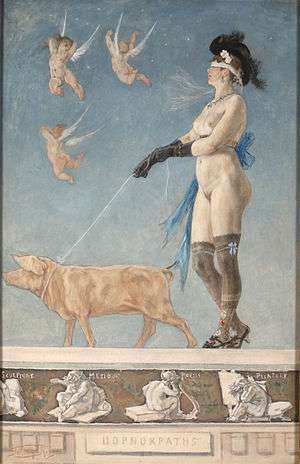Pornocrates
Pornocrates, Pornokratès, La dame au cochon, or The Lady with the Pig is a work by the Belgian artist Félicien Rops, created in 1878. It is part of the collection of the Musée provincial Félicien Rops in Namur, Belgium.
| Pornocrates | |
|---|---|
| Pornokratès, La dame au cochon | |
 | |
| Artist | Félicien Rops |
| Year | 1878 |
| Type | Gouache and watercolor painting |
| Dimensions | 75 cm × 48 cm (30 in × 19 in) |
| Location | Musée provincial Félicien Rops, Namur |
The work in Namur is 75 cm high and 48 cm wide, executed in gouache and watercolor paint heightened with pastel on paper. Reproductions of the work (soft-ground etchings, heliogravures and aquatints, sometimes colored) are also present in other museum collections, such as the LACMA, the National Museum of Western Art and the Rijksmuseum Amsterdam.
Description
Pornocrates is considered the best-known work by Rops.[1] It was realized at a time when Rops was 45 years old and lived in Paris together with the sisters Léontine and Aurélie Duluc, who both were his mistresses and became mothers to his children.[2] The title of the work can be translated as "the ruler of fornication". According to his own correspondence, Rops produced this painting "in an overheated apartment, full of different smells, where the opopanax and cyclamen gave me a slight fever conducive towards production or even towards reproduction".[3] The work depicts a woman, holding a swine on a leash, viewed from the left side. The woman, said to be a courtesan, is almost naked, with the exception of long black silk gloves, a blindfold, a plumed hat, black shoes and stockings, and a band of gold and blue silk – accessories which only emphasize her nakedness.[4] Above the pig with golden tail, three winged putti fly away in what looks like shock or horror. Rops refers to them as "Three loves – ancient loves – vanish in tears".[3]
Meaning of the work
Various interpretations for the work exist. The woman can be seen as a powerful female, led by the hog, which can be seen as an image of a man in a bestial, submissive and ignorant state, kept in check by the woman. The pig with golden tail can also be seen as an allegory for luxury, or even as an animal of the devil,[1] a symbol of fornication, steering the woman in blindness. In any case the work represents Rops' vision of the woman of his time: a femme fatale who was increasingly assertive, ruthless and seductive.[5] "She was the human animal viciously depicted by Félicien Rops as "Pornokrates", ruler of Proudhon's "Pornocracy", a creature blindly guided by a hog, the symbol of Circe, the bestial representative of all sexual evil".[6]

The woman and pig are walking on top of a marble stage,[7] with a frieze depicting four allegories of the arts: sculpture, music, literature and painting. The fine arts are depicted as grey, classical male figures, looking desperate. This might be interpreted as the victory of sensuousness and eroticism of the art that Rops and his contemporaries of the Decadent movement created, in contrast with the boredom of the academic art of that era.[4]
The title may also refer to the concept of pornocracy, a period in the History of the papacy during the first half of the 10th Century where the Popes were strongly influenced by a corrupt aristocratic family, the Theophylacti. Pierre-Joseph Proudhon published his anti-feminist tract La Pornocratie ou les femmes dans les temps modernes in 1875, three years before Rops worked on his Pornocrates.
An early owner of the work was the Belgian jurist and art collector Edmond Picard.[8] Pornocrates was received with indignation and scandal during the 1886 exhibition of the Cercle des XX, an art group to which Rops belonged.[8]
Gallery
 Soft-ground etching (1896) at LACMA
Soft-ground etching (1896) at LACMA.jpg) Etching with watercolours, private collection
Etching with watercolours, private collection Heliogravure (1896) at musée provincial Félicien Rops
Heliogravure (1896) at musée provincial Félicien Rops
External links
| Wikimedia Commons has media related to Pornokratès by Félicien Rops. |
- Pornocrates on Europeana.eu
- Pornocrates on the website of Musée Félicien Rops (in French)
- Etching in the collection of LACMA
- Etching/aquatint in the collection of the National Museum of Western Art, Tokyo
- La Pornocratie ou les femmes dans les temps modernes by Pierre-Joseph Proudhon on French Wikisource
References
- Leblanc, Véronique (20 April 2006). "Pornocratès, 1878". Musée provincial Félicien Rops Namur. Retrieved 15 April 2016.
- Smets, Joëlle (3 March 2016). "Félicien Rops: Pornokratès". lesoir.be. Le Soir. Retrieved 15 April 2016.
- Letter from Félicien Rops to H. Liesse, 1879.
- Felicien Rops Pornocrates – YouTube video with interpretation of the work
- Dorhout, Pauline (10 February 2013). "Félicien Rops: Pornocrates (1878); Musée Félicien Rops, Namur". The World According to Art. Retrieved 15 April 2016.
- Dijkstra, Bram (1986). Idols of Perversity. Fantasies of Feminine Evil in Fin-de-Siècle Culture. Oxford: Oxford University Press. pp. 325. ISBN 9780195037791.
- "Drawing – Pornokratès". Musée Félicien Rops. Retrieved 15 April 2016.
- "Pornokratès ou La Femme au cochon". numeriques.be. Retrieved 15 April 2016.